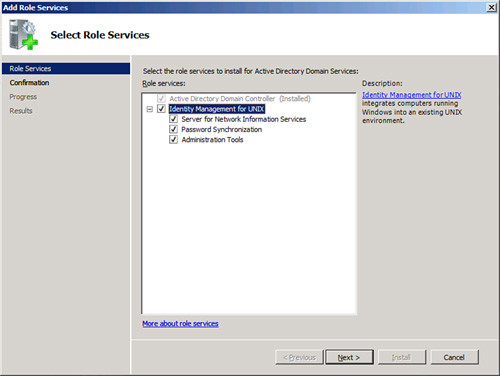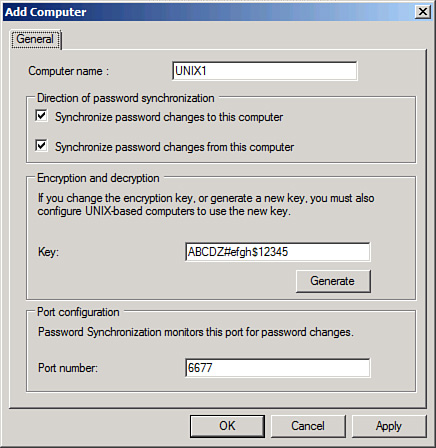The goal of single sign-on, in
which users on a network log in once and then have access to multiple
resources and environments, is still a long way off. It is common for a
regular user to maintain and use three or more separate usernames and
associated sets of passwords. Windows Server 2008 UNIX Integration goes a
long way toward making SSO a reality, however, with the Identity
Management for UNIX Role Service.
Identity Management for
UNIX is an additional role service on a Windows Server 2008 machine that
includes three major components as follows:
Server for Network Information Services
(SNIS)— Server for NIS enables a Windows
AD DS environment to integrate directly with a UNIX NIS environment by
exporting NIS domain maps to AD entries. This enables an AD Domain
Controller to act as the master NIS server.
Password Synchronization— Installing the Password Synchronization role on a
server enables for passwords to be changed once and to have that change
propagated to both UNIX and AD DS environments.
Administrative Tools— Installing this role service gives
administrators to tools necessary to administer the SNIS and Password
Synch components.
The
Identity Management for UNIX components have some other important
prerequisites and limitations that must be taken into account before
considering them for use in an environment. These factors include the
following:
Server
for Network Information Services (SNIS) must be installed on an Active
Directory domain controller. In addition, all domain controllers in the
domain must be running Server for NIS.
SNIS must not be subservient to a UNIX NIS
Server—it can be subservient only to another Windows-based server
running Server for NIS. This requirement can be a politically sensitive
one and should be broached carefully because some UNIX administrators
will be hesitant to make the Windows-based NIS the primary NIS server.
The SNIS Authentication component
must be installed on all domain controllers in the domain in which
security credentials will be utilized.
Installing
Identity Management for UNIX Components
To install one or all
of the Identity Management for UNIX components on a Windows Server 2008
domain controller, perform the following steps:
1. | Open Server Manager (Start, All Programs, Administrative
Tools, Server Manager).
|
2. | Click on the Roles node in the task pane and then click
the Add Role Services link in the Active Directory Domain Services
section.
|
3. | Check the
box next to Identity Management for UNIX, which should automatically
check the remaining boxes as well, as shown in Figure 1. Click Next to
continue.

|
4. | Review the installation options and click Install
to begin the process.
|
5. | Click Close when complete and choose Yes to restart the
server.
|
6. | After
restart, the server should continue with the configuration of the
server. Let it finish and click Close when the process is complete.
|
Configuring
Password Change Capabilities
To enable
password change functionality, a connection to a UNIX server must be
enabled. To set up this connection, perform the following steps:
1. | Open the MMC Admin Console (Start, All Programs,
Microsoft Identity Management for UNIX).
|
2. | From the Node pane, navigate to Password
Synchronization, UNIX-Based Computers.
|
3. | Right-click UNIX-Based Computers and choose Add
Computer from the drop-down box.
|
4. | Enter a Computer name of the UNIX box, and specify
whether to synch passwords to/from UNIX. Enter the port required for
password synch and an encryption key that is mutually agreed upon by the
UNIX server, similar to what is shown in Figure 2. Click OK.

|
5. | Click OK
to confirm the addition of the UNIX system.
|
Adding NIS Users
to Active Directory
For users who want their existing NIS servers
to continue to provide authentication for UNIX and Linux servers, the
SNIS component might not be the best choice. Instead, there is a package
of Korn shell scripts downloadable from Microsoft.com that simplifies adding existing NIS users to AD.
The getusers.ksh script gets a list of all users in an NIS database
including the comment field. This script must be run with an account
with the permission to run ypcat passwd. The makeusers.ksh script imports these users to Active
Directory. The makeusers.ksh script must be run by a user with domain
admin privileges. The –e flag enables accounts because by default the
accounts are created in a disabled state. This is a perfect solution for
migrations that require the existing NIS servers to remain intact
indefinitely.